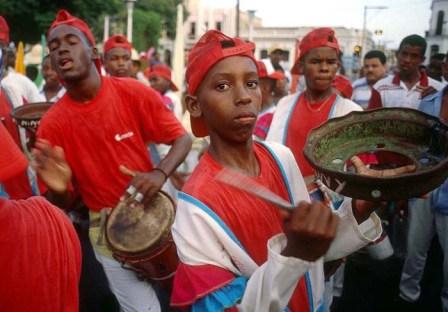My Home Town Carnival
Daisy Valera

The “Santiago Espirituano” is the oldest, most popular and most important fiesta in the province where I was born. In colonial times this area was called Villa del Espiritu Santo, but today it’s named Sancti Spiritus Province.
Its carnivals —as everyone here will tell you— run between July 22 and 27, and after about four years of being away I had the opportunity last month to attend them.
The festivities haven’t changed much since I left. The neighborhoods are assaulted by an immense number of people who come from all the surrounding municipalities of the province to celebrate.
The streets are decorated and large quantities of beer and food begin to be sold; this ranges from traditional bread and pork to Chinese cuisine. Plus there’s music for all tastes; you only have to walk until you find the right spot, and the partying goes on 24 hours a day.
In the city’s main park they sell masks, and on one stage there are groups sing traditional trova and son music. The Sancti Spiritus carnival has survived the country’s formidable economic problems and is a moment of relaxation and respite for all those who live in the city.
But the carnivals are pure magic for some of us; these are the children of the city. At this time of the year the streets remind me of my own childhood, because this fiesta is not only for adults. During that period parents have the perfect opportunity to take their children out for a good time. In all corners of town pass parade floats that look like carrousels, or ships that sway like giant pendulums, and airplanes and stars that circle with arrays of colored lights.
Though made by hand, the floats are crafted with care, and they’re always able to whip up laughter and shouts of joy. Without a doubt, a great part of this celebration is for the children, since the fiesta is not short of cotton candy machines or popcorn stands. In the lines are those waiting to buy these treats for their children.
Some kids take advantage of the time to ride their bicycles or carts along streets cleared of traffic specifically for this purpose. Childhood for Cubans is beautiful, but it’s even more so in smaller provinces like Sancti Spiritus. In places like this, children do not yet feel so different; they go on into the street indifferent about their brand of clothes, and it doesn’t yet concern them whether their parents are bricklayers or doctors.
Cuban children have studying as their sole duty, not trying to earn a little money for food like in other countries of the world. They don’t know about drugs or prostitution. Most share the same games and forms of entertainment, ones that have nothing to do with the purchasing power of their parents. They have faces of innocence and lack of concern, because everything revolves around ensuring their happiness.
The provincial carnivals are only a small demonstration of the importance placed on the early years of life in Cuba. The fact that the children of the island have a happy childhood is one achievement of a country that has selected a socialist path, where social differences and private property are not present to transform our children into class enemies or wage-labor workers.





